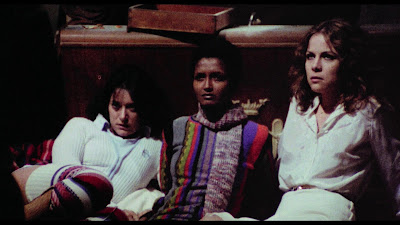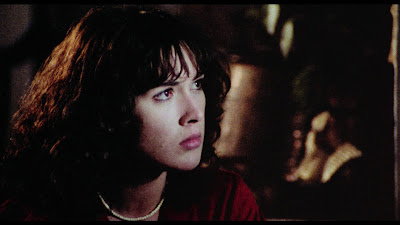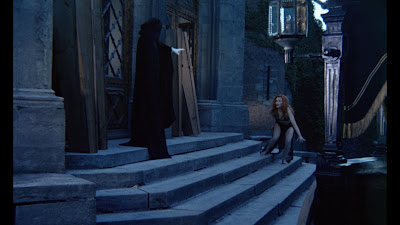Reviewed by Steve Fenton.
Let’s get one thing straight right at the start: coming as it did from 1988 (i.e., during the ‘last gasp’ of Italo trash cinema), as well as from low-end exploitationeer Bruno Mattei (using his infamous “Vincent Dawn” pseudonym), ROBOWAR is pure, undiluted exploitation mindrot that makes absolutely no bones about who and what it’s exploiting. Over the course of its brisk 88-minute runtime, it succeeds in—well, triesto, at least—ripping-off elements from ROBOCOP (as the title most obviously suggests), PREDATOR (especially that film!), the entire Rambo series, ALIENS, and also Arnold Schwarzenegger’s then-recent campy combat actioner COMMANDO, with a dash of Oliver Stone’s PLATOON thrown in for good measure.
Whole segments from ROBOWAR’s principal influence source PREDATOR are lifted almost verbatim and given the low-budget rerun-through. There are skinned human carcasses hung in trees and a bit where our mucho-macho ‘heroes’ use their arsenal of big guns like high-calibre Weed-Whackers in order to rout the hidden menace possibly lurking in the bush (“Whoever it was, it ain’t no more!”); indeed, as if to belabor this obvious nod to PREDATOR, there are numerous scenes of the heroes shooting wildly into the undergrowth elsewhere throughout, so obviously the minimal budget at least allowed for an unlimited amount of ammo to be fired-off! Playing one Major Murphy Black (“...better-known as ‘Kill-Zone’!”), Reb Brown leads a ‘crack’ expeditionary force of mercenaries somewhere deep in a Latin-American (or is it Southeast Asian?) jungle. Amongst others under Brown-as-Black’s command is well-seasoned spaghetti stunt-grunt Romano Puppo, who appears highly credible as the outfit’s grizzled, grim-faced senior member, Corporal Neil Corey (“Expert heavy weapons, top marksman rating…”), while Massimo Vanni, better-known to some as “Alex McBride”, plays Private Larry Guarino, alias “Diddy-Bopper” (?!) or just plain “Diddy” for short. As the squad’s shortest member and (quote) “crack reconnaissance man”, “McBride”/Vanni does a loose impression of Chuck Norris (circa that worthy’s Missing in Action stints), with mirror-shades, erect triceps, unkempt facial growth and all. Like Puppo an experienced fall guy in his own right, Vanni—best-known for his work on ’70s/’80s Italocrimers—also served as the film’s stunt coordinator (utilizing local Filipino stuntmen, who had plenty of experience in this sort of thing, as, not only were many European and American ‘tourist’ productions being shot in the Philippines at the time, but the nation simultaneously had its own then-thriving action movie industry too). Receiving plentiful screen-time herein, physically imposing (roughly 6-foot-5-inch) Pinoy actor Max Laurel (who played the titular snake/man-monster in both Jun Raquiza’s ZUMA [1985] and Ben Yalung’s sequel ANAK NI ZUMA [1987]) appears as Quang, the squad’s sole Asian (as in South Vietnamese) member and laconic pointman.
Collectively nicknamed BAM, an acronym for “Big-Assed Motherfuckers” (in our opinion, “BadassMofos” has a much better ring to it, but I guess something got lost in translation), our ‘dirty half-dozen’ are there to track down a renegade, gone-AWOL military cyborg as well as battle token revolutionary guerillas (who are present merely to up the gratuitous body-count during loads of chaotic combat scenes). Him—er, it?—known as “Omega I” is a bionic half-man/half-robot super-soldier invented by an unscrupulous techie named Mascher (played by Mel Davidson, wildly under- and overacting by turns) for use in militarily difficult theatres of war. To add some extra ‘dramatic tension’ to the proceedings, it develops that Omega incorporates various leftover bits-’n’-pieces of Reb’s ex-’Nam vet buddy, who was blown apart by a ’Cong land-mine.
Catherine Hickland (playing a chick named “Virgin” [yeah, right!]) is a blonde white missionary the squad picks up along the way, who eventually takes up arms—albeit without ever even coming close to actually shooting anything!—against the delinquent cyborg. Handling her M-16 like a squeeze-mop, rather than bother trying to come across like some kickass Sigourney Weaver clonette, Ms. Hickland instead plays seventh fiddle to the boys and steers clear of the gunfights. During these, lots of innocent incidental shrubbery (courtesy of the Filipino locations) and low-rent jungle real estate get blowed-up real good care of economical-if-energetic pyrotechnical effects.
Realization of the supposedly terrifying Omega droid is tawdrily shoddy in the extreme, it should—and indeed, must—be said. Super Force (1990), US TV’s own ROBOCOP rip-off from the same period, boasted a much more ominous-looking costume, and that guy was the hero! In the long run, ROBOWAR’s sub-state-of-the-art biomechanical menace comes across about as intimidating as your average 8-inch toy action figure. Indeed, the most-realistic aspect of Omega’s get-up is its black-painted football-cum-motorcycle crash helmet with smoked plastic visor; its least-convincing aspect being the urine-tinted, fuzzily digitized POV shots (accompanied by an overlaid gibberish of electronic tonalities) that indicate its heavily-pixelated worldview. For the most part, DP Riccardo Grassetti’s camerawork is efficiently functional, looking all the easier on the eyeballs in Severin’s pristine BD edition, and the crisp cinematography makes special makeup-man Franco Di Girolamo’s gnarly ‘putrefying cadaver’ effects appear that much gnarlier.
The affably dudebro-ish Brown—some of whose career ‘highpoints’ are a couple of Captain America TV movies and “Anthony M. Dawson”/Antonio Margheriti’s prehysterical schlock sci-fi epic YOR: THE HUNTER FROM THE FUTURE (1983)—spends most of his screen-time looking like either a mildly-startled bullock or an embarrassed Myrtle Beach surfer dude (or both at once). Possibly the Omega reminded Reb of resident supervillain Overlord’s pet ’bots in YOR too much, and made him nervous? His California beach bum act (complete with jet-black headband, as per his onscreen surname) is mostly played tongue-in-cheek, although he really gives his all in some scenes (you’ll know ’em when you see ’em!). But, was our Reb starting to look more and more like Doug McClure (especially in his career moves) during this period in his career? At one juncture, Brown pins a guerilla to the side of a native hut with a thrown knife. With the punchline-timing of an Arnie or Freddy, he then proceeds to deadpan, “Don’t move!”
After ROBOWAR and his work on Fulci’s lamentable and virtually unsalvageable ‘unfinished mantelpiece’ ZOMBIE 3, it seems as though Bruno Mattei’s best effort, in this writer’s opinion, shall remain the nasty nunsploitation shocker THE OTHER HELL (1981); although, since Mattei openly admitted he’d never made a good film anyway, my opinion is entirely disposable. In the present offering, the director throws our way sufficient explosions, f-bombs—including a surprising number from former ‘boy-next-door’ Brown—unexpectedly competent and grisly after-the-fact gore FX, as well as prodigious amounts of asinine dialogue, that there’s not much time left to dwell on ROBOWAR’s shortcomings, when all is said and done… it definitely does entertain, and that’s the main thing.
Final verdict: ROBOWAR is an absolutely vacuous but fun timewaster for undemanding fans of such fare; nothing less, and certainly nothing more. As rampaging sub-zero cyborg exploitation goes, gimme FRANKENSTEIN MEETS THE SPACE MONSTER any day, but for 1980s future schlock sci-fi, the present film ain’t too shabby at all (especially when you consider some of the far-crappier and less-energetic American-made STV [“straight-to-video”] ROBOCOP/ PREDATOR imitations that were released back then). Al Festa’s noodly synth electrobeat/cheese metal score is late-’80s all the way, and doesn’t sound half-bad even in 2019; who cares that incidental songs are periodically superimposed atop the action on a seemingly random basis, without rhyme nor reason?! While it’s been very nearly 30 years (GULP!) since I last killed X number of brain-cells watching ROBOWAR, in retrospect—especially in light of its latest, optimal incarnation on Blu-ray—it looks a whole lot better (in more ways than one) than I remember it being the first time round.
In conclusion: let’s hear it for Reb Brown, the “Doug McClure” of the ’80s and ’90s!
Like Mattei’s other unashamedly—and highly-enjoyable—rip-off, SHOCKING DARK (1990), ROBOWAR was also never officially released in either the U.S. or Canada in any form, and it first gained notoriety among discerning cineastes via Columbia Home Video’s Japanese VHS videocassette release. In English with Japanese subtitles, Columbia’s tape also retained the film’s original 1.85:1 aspect ratio, and it remained the optimum release for more than two decades prior to Severin’s long-overdue Blu-ray. Scanned in 4K from the original camera negative, this all-region edition is virtually flawless, boasting razor-sharp detail and a bold, lush colour scheme, which is especially attractive considering that the entire narrative unfolds in a tropical rainforest. However, this added clarity also draws attention to the film’s ‘rough edges’, including the hilariously thrifty robo-suit. The DTS-HD MA 2.0 audio is provided in both English and Italian (with optional SDH and newly-translated English subtitles, respectively), and while there are some minor differences between the two tracks, it’s pretty hard to resist the film’s animated and sometimes highly-surreal English audio, which at times is a real hoot (e.g., “C’mon, Doc, you walk like a ruptured duck!”).
Containing a whopping six (!) special featurettes, the extras begin with Robo Predator (23m06s), an on-camera interview with writer/director Claudio Fragasso (a.k.a. “Clyde Anderson”), who shares his memories of working with Bruno Mattei and their cost-effective technique of shooting two different films simultaneously, beginning with their earliest collaborations, THE TRUE STORY OF THE NUN OF MONZA (1980) and THE OTHER HELL (1980), and later ROBOWAR along with Fragasso’s zombie film AFTER DEATH (1988), which they shot using only one camera! He also praises Mattei for his prowess as an editor, and how at one point he had to step in and direct a few sequences when Mattei fell ill. In Italian Rip-Off (9m18s), screenwriter Rossella Drudi gives her thoughts on the genesis of the film, and how she and Fragasso were commissioned to deliver a (quote) “part-PREDATOR, part-ROBOCOP, and part-ALIEN” film for producer Franco Gaudenzi. Drudi also admits how initially she wasn’t very fond of ROBOWAR, but after re-watching the film, she has become more forgiving (“It’s a nice movie. It’s very funny!”). Drudi pops-up again in Violence, She Wrote (21m05s) for a career-spanning interview, which is similar to the one she shared with Claudio Fragasso on Severin’s BD of VIOLENCE IN A WOMEN’S PRISON (1983). Nevertheless, in this new featurette, she shares a number of interesting stories as one of the very few female screenwriters associated—at that time, at least—with the horror genre.
The film’s leading lady, Catherine Hickland submits to an interview in Robolady (11m34s), during which she reminiscences about the unforgiving Philippine locations and how (quote) “There were a lot of surprises there for me”; she also speaks fondly of the cast and crew, despite some of them only speaking Italian (including director Mattei). In addition she discusses leading man Reb Brown’s (quote) “utter commitment”, no matter what the scene called for (this dedication is never more apparent than when Brown daringly leaps from atop a lofty cataract into a pool far below, and also during a strangely poignant anticlimactic scene at the end when he convincingly sheds tears over what his fallen ’Nam comrade-at-arms has become). In Papa Doc’s War (12m50s), American actor John P. Dulaney briefly discusses his career in Italian cinema and how he ended-up in the Philippines thanks to his friend, actor Mike Monty; the hot ’n’ humid locations; and how Mattei instructed everyone to yell incessantly while firing their machineguns. Actor Jim Gaines, Jr. is interviewed in The Robo Warrior (9m02s), wherein he primarily talks about how ROBOWAR was shot simultaneously with AFTER DEATH, as well as relating a number of funny anecdotes. Finally, in War of the Philippines (17m32s), actor/stuntman Massimo Vanni, who went by the anglicized pseudonym “Alex McBride” for most of his ’80s work, speaks warmly of working with Mattei, and how he initially got to know him via his cousin, editor Vincenzo Vanni. He goes on to discuss Mattei’s and Fragasso’s working relationship and how he enjoyed making (quote) “homemade” versions of Hollywood blockbusters.
Additionally, this already extras-packed release includes Catherine Hickland’s Behind the Scenes Home Videos (15m14s), which is narrated by Hickland herself and features most of the cast and crew enjoying their time on-set and also includes an appearance by long-time actor Luciano Pigozzi (see note below). ROBOWAR’s trailer finishes-off the extras. For the first 3000 copies of the run, Al Festa’s score is included on a bonus CD. The film is currently available through Severin as a Limited Edition Blu-ray, DVD or as part of a Robowar bundle. For you Canadian readers, copies can be obtained from Suspect Video.
Note: Evidently, some scenes featuring long-time Italian character player Luciano Pigozzi (a.k.a. “Alan Collins”) were shot, but for whatever reason got excised from the final cut. Coincidentally enough, the same thing supposedly happened to the same actor on Mattei’s hilariously out-of-whack Vietnam War-set poliziesco COP GAME (1988), yet the name “Alan Collins” remains in its opening credits (as it also does on ROBOWAR), despite Pigozzi himself being nowhere to be seen in the flesh.


























